Spatiotemporal Dynamic Distribution, Regional Differences and Spatial Convergence Mechanisms of Carbon Emission Intensity: Evidence from the Urban Agglomerations in the Yellow River Basin
Abstract
1. Introduction
2. Materials and Methods
2.1. Study Area
2.2. Data Source and Processing
2.3. Methods
2.3.1. Spatial Markov Chain
2.3.2. Dagum’s Gini Coefficient and Decomposition
2.3.3. Spatial Convergence Analysis
3. Results
3.1. Spatiotemporal Distribution Dynamics of CEI of Urban Agglomerations in the YRB
3.1.1. Spatiotemporal Distribution Characteristics
3.1.2. Spatiotemporal Transfer Characteristics
3.2. Regional Differences in CEI of Urban Agglomerations in the YRB
3.2.1. Differences within Urban Agglomeration
3.2.2. Differences between Urban Agglomerations
3.2.3. Contribution of Differences
3.3. Spatial Convergence Analysis of the CEI of Urban Agglomerations in the YRB
3.3.1. σ Convergence
3.3.2. Absolute β Convergence
3.3.3. Conditional β Convergence and Carbon Emission Reduction Effect
3.3.4. Robustness Test
4. Conclusions and Suggestions
4.1. Conclusions
4.2. Suggestions
Author Contributions
Funding
Institutional Review Board Statement
Informed Consent Statement
Data Availability Statement
Conflicts of Interest
References
- Falahatkar, S.; Rezaei, F. Towards low carbon cities: Spatio-temporal dynamics of urban form and carbon dioxide emissions. R. Sens. Appli. Soc. Environ. 2020, 18, 100317. [Google Scholar] [CrossRef]
- Cui, C.; Cai, B.F.; Bin, G.S.; Wang, Z. Decennary spatial pattern changes and scaling effects of CO2 emissions of urban agglomerations in China. Cities 2020, 105, 102818. [Google Scholar] [CrossRef]
- Bai, Y.P.; Deng, X.Z.; Gibson, J.; Zhao, Z.; Xu, H. How does urbanization affect residential CO2 emissions? An analysis on urban agglomerations of China. J. Clean. Prod. 2019, 209, 876–885. [Google Scholar] [CrossRef]
- Liu, B.Q.; Tian, C.; Li, Y.Q.; Song, H.H.; Ma, Z.X. Research on the effects of urbanization on carbon emissions efficiency of urban agglomerations in China. J. Clean. Prod. 2018, 197, 1374–1381. [Google Scholar] [CrossRef]
- Li, X.Y.; Xu, H.Z. Effect of local government decision-making competition on carbon emissions: Evidence from China’s three urban agglomerations. Bus. Strategy Environ. 2020, 29, 2418–2431. [Google Scholar] [CrossRef]
- Wang, F.; Fan, W.N.; Liu, J.; Wang, G.; Chai, W. The effect of urbanization and spatial agglomeration on carbon emissions in urban agglomeration. Environ. Sci. Pollut. R. 2020, 27, 24329–24341. [Google Scholar] [CrossRef]
- Han, F.; Xie, R.; Fang, J.Y.; Liu, Y. The effects of urban agglomeration economies on carbon emissions: Evidence from Chinese cities. J. Clean. Prod. 2018, 172, 1096–1110. [Google Scholar] [CrossRef]
- Zheng, R.J.; Cheng, Y.; Liu, H.M.; Chen, W.; Chen, X.D.; Wang, Y.P. The Spatiotemporal Distribution and Drivers of Urban Carbon Emission Efficiency: The Role of Technological Innovation. Int. J. Environ. Res. Public Health 2022, 19, 9111. [Google Scholar] [CrossRef]
- Zhou, Y.; Chen, M.X.; Tang, Z.P.; Mei, Z.A. Urbanization, land use change, and carbon emissions: Quantitative assessments for city-level carbon emissions in Beijing-Tianjin-Hebei region. Sustain. Cities Soc. 2021, 66, 102701. [Google Scholar] [CrossRef]
- Yu, X.; Wu, Z.Y.; Zheng, H.R.; Li, M.Q.; Tan, T.L. How urban agglomeration improve the emission efficiency? A spatial econometric analysis of the Yangtze River Delta urban agglomeration in China. J. Environ. Manag. 2020, 260, 110061. [Google Scholar] [CrossRef]
- Lv, T.G.; Hu, H.; Zhang, X.M.; Xie, H.L.; Fu, S.F.; Wang, L. Spatiotemporal pattern of regional carbon emissions and its influencing factors in the Yangtze River Delta urban agglomeration of China. Environ. Monit. Assess 2022, 194, 515. [Google Scholar] [CrossRef] [PubMed]
- Chen, L.; Xu, L.Y.; Yang, Z.F. Inequality of industrial carbon emissions of the urban agglomeration and its peripheral cities: A case in the Pearl River Delta, China. Renew. Sustain. Energy Rev. 2019, 109, 438–447. [Google Scholar] [CrossRef]
- Jin, F. Coordinated promotion strategy of ecological protection and high-quality development in the Yellow River Basin. Reform 2019, 11, 33–39. (In Chinese) [Google Scholar]
- Yuan, X.L.; Sheng, X.R.; Chen, L.P.; Tang, Y.Z.; Li, Y.; Jia, Y.S.; Qu, D.F.; Wang, Q.S.; Ma, Q.; Zuo, J. Carbon footprint and embodied carbon transfer at the provincial level of the Yellow River Basin. Sci. Total Environ. 2022, 803, 149993. [Google Scholar] [CrossRef]
- Lv, Q.; Liu, H.B. Multiscale spatio-temporal characteristics of carbon emission of energy consumption in Yellow River basin based on the nighttime light datasets. Econ. Geogr. 2020, 40, 12–21. (In Chinese) [Google Scholar]
- Du, H.B.; Wei, W.; Zhang, X.Y.; Ji, X. Spatio-temporal evolution and influencing factors of energy-related carbon emissions in the Yellow River Basin: Based on the DMSP/OLS and NPP/VIIRS nighttime light data. Geogr. Res. 2021, 40, 2051–2065. (In Chinese) [Google Scholar]
- Zhang, H.M.; Yuan, P.F.; Zhu, Z.S. Decoupling effects of carbon emissions and reduction path in the Yellow River Basin. Resour. Sci. 2022, 44, 59–69. (In Chinese) [Google Scholar] [CrossRef]
- Zhang, Y.; Xu, X.Y. Carbon emission efficiency measurement and influencing factor analysis of nine provinces in the Yellow River basin: Based on SBM-DDF model and Tobit-CCD model. Environ. Sci. Pollut. Res. 2022, 29, 33263–33280. [Google Scholar] [CrossRef]
- Han, Y.; Wang, X.P.; Zhe, C.H. Carbon Emissions, Ecological Efficiency, and the Economic Development Stage: Evidence from the Yellow River Basin. Sci. Program.-Neth. 2022, 2022, 2216781. [Google Scholar] [CrossRef]
- Chen, X.L.; Meng, Q.G.; Shi, J.N.; Liu, Y.F.; Sun, J.; Shen, W.F. Regional Differences and Convergence of Carbon Emissions Intensity in Cities along the Yellow River Basin in China. Land 2022, 11, 1042. [Google Scholar] [CrossRef]
- Sun, X.M.; Zhang, H.T.; Ahmad, M.; Xue, C.K. Analysis of influencing factors of carbon emissions in resource-based cities in the Yellow River basin under carbon neutrality target. Environ. Sci. Pollut. R. 2022, 29, 23847–23860. [Google Scholar] [CrossRef] [PubMed]
- Zhang, Y.; Yu, Z.; Zhang, J. Spatiotemporal evolution characteristics and dynamic efficiency decomposition of carbon emission efficiency in the Yellow River Basin. PLoS ONE 2022, 17, e0264274. [Google Scholar] [CrossRef] [PubMed]
- Xu, Y.Q.; Cheng, Y.; Zheng, R.J.; Wang, Y.P. Spatiotemporal Evolution and Influencing Factors of Carbon Emission Efficiency in the Yellow River Basin of China: Comparative Analysis of Resource and Non-Resource-Based Cities. Int. J. Environ. Res. Public Health 2022, 19, 11625. [Google Scholar] [CrossRef] [PubMed]
- Song, H.H.; Gu, L.Y.; Li, Y.F.; Zhang, X.; Song, Y. Research on Carbon Emission Efficiency Space Relations and Network Structure of the Yellow River Basin City Cluster. Int. J. Environ. Res. Public Health 2022, 19, 12235. [Google Scholar] [CrossRef]
- Yang, Y.J.; Li, H.Y. Monitoring spatiotemporal characteristics of land-use carbon emissions and their driving mechanisms in the Yellow River Delta: A grid-scale analysis. Environ. Res. 2022, 214, 114151. [Google Scholar] [CrossRef]
- Li, S.X.; Cheng, Z.H.; Tong, Y.; He, B. The Interaction Mechanism of Tourism Carbon Emission Efficiency and Tourism Economy High-Quality Development in the Yellow River Basin. Energies 2022, 15, 6975. [Google Scholar] [CrossRef]
- Zhang, G.X.; Su, Z.X. Analysis of influencing factors and scenario prediction of transportation carbon emissions in the Yellow River basin. Manag. Rev. 2020, 32, 283. (In Chinese) [Google Scholar]
- Zhang, P.Y.; Pang, B.; Li, Y.Y.; He, J.J.; Hong, X.; Qin, C.Z.; Zheng, H. Analyzing spatial disparities of economic development in Yellow River Basin, China. GeoJournal 2019, 84, 303–320. [Google Scholar] [CrossRef]
- Wang, J.T.; Liu, H.B.; Peng, D.; Lv, Q.; Sun, Y.; Huang, H.; Liu, H. The County-Scale Economic Spatial Pattern and Influencing Factors of Seven Urban Agglomerations in the Yellow River Basin—A Study Based on the Integrated Nighttime Light Data. Sustainability 2021, 13, 4220. [Google Scholar] [CrossRef]
- Fang, C. Spatial organization pattern and high-quality development of urban agglomeration in the Yellow River Basin. Econ. Geogr. 2020, 40, 1–8. (In Chinese) [Google Scholar]
- Ma, H.T.; Xu, X.F. High-Quality development assessment and spatial heterogeneity of urban agglomeration in the Yellow River Basin. Econ. Geogr. 2020, 40, 11–18. (In Chinese) [Google Scholar]
- Rey, S.J. Spatial empirics for economic growth and convergence. Geogr. Anal. 2001, 33, 195–214. [Google Scholar] [CrossRef]
- Zhao, G.; Chen, L.; Sun, L.; Zhao, G. Markov steady state prediction of carbon emission intensity in China based on the perspective of spatial differentiation. Sci. Technol. Manag. Res. 2017, 37, 228–233. (In Chinese) [Google Scholar]
- Le Gallo, J. Space-time analysis of GDP disparities among European regions: A Markov chains approach. Int. Regional Sci. Rev. 2004, 27, 138–163. [Google Scholar] [CrossRef]
- Mu, X.Q.; Guo, X.Y.; Ming, Q.Z.; Hu, C. Dynamic evolution characteristics and driving factors of tourism ecological security in the Yellow River Basin. Acta Geogr. Sin. 2022, 77, 714–735. (In Chinese) [Google Scholar]
- Wang, S.J.; Huang, Y.Y.; Zhou, Y.Q. Spatial spillover effect and driving forces of carbon emission intensity at the city level in China. J. Geogr. Sci. 2019, 29, 231–252. [Google Scholar] [CrossRef]
- Zhang, Z.Q.; Zhang, T.; Feng, D.F. Study on Regional Differences, Dynamic Evolution and Convergence of Carbon Emission Intensity in China. J. Quant. Tech. Econ. 2022, 39, 67–87. (In Chinese) [Google Scholar]
- Dagum, C. Decomposition and interpretation of Gini and the generalized entropy inequality measures. Statistica 1997, 57, 295–308. [Google Scholar]
- Solow, R.M. A contribution to the theory of economic growth. Quar. J. Econ. 1956, 70, 65–94. [Google Scholar] [CrossRef]
- Pettersson, F.; Maddison, D.J.; Acar, S.; Söderholm, P. Convergence of carbon dioxide emissions: A review of the literature. Inter. Rev. Environ. Res. Econ 2014, 7, 141–178. [Google Scholar] [CrossRef]
- Aldy, J.E. Per capita carbon dioxide emissions: Convergence or divergence? Environ. Res. Econ. 2006, 33, 533–555. [Google Scholar] [CrossRef]
- Jobert, T.; Karanfil, F.; Tykhonenko, A. Convergence of per capita carbon dioxide emissions in the EU: Legend or reality? Energy Econ. 2010, 32, 1364–1373. [Google Scholar] [CrossRef]
- Song, M.; Zou, S.J. Regional Differences, Convergence and Influencing Factors of Carbon Emissions Efficiency in the Yellow River Basin. Yellow River 2022, 44, 6–12+56. (In Chinese) [Google Scholar]
- Rey, S.J.; Dev, B. σ-convergence in the presence of spatial effects. Pap. Reg. Sci. 2006, 85, 217–234. [Google Scholar] [CrossRef]
- Barro, R.J. Economic growth in a cross section of countries. Quar. J. Econ. 1991, 106, 407–443. [Google Scholar] [CrossRef]
- Ying, L.G. Measuring the spillover effects: Some Chinese evidence. Pap. Reg. Sci. 2000, 79, 75–89. [Google Scholar] [CrossRef]
- Kou, Z.L.; Liu, X.Y. China’s Urban and Industrial Innovation Report 2017; Industrial Development Research Center of Fudan University: Shanghai, China, 2017. (In Chinese) [Google Scholar]
- Yuan, H.; Zhu, C.L. Do national high-tech zones promote the transformation and upgrading of China’s industrial structure. China Indus. Econ. 2018, 8, 60–77. (In Chinese) [Google Scholar]
- Gan, C.H.; Zheng, R.G.; Yu, D.F. An empirical study on the effects of industrial structure on economic growth and fluctuations in China. Econ. Res. J. 2011, 5, 4–16. (In Chinese) [Google Scholar]
- Zhao, X.G.; Zhu, J. Industrial restructuring, energy consumption and economic growth: Evidence from China. J. Clean. Prod. 2022, 335, 130242. [Google Scholar]
- Bickenbach, F.; Bode, E. Evaluating the Markov property in studies of economic convergence. Int. Reg. Sci. Rev. 2003, 26, 363–392. [Google Scholar] [CrossRef]
- Shao, S.; Fan, M.T.; Yang, L.L. Economic restructuring, green technical progress, and low-carbon transition development in China: An empirical investigation based on the overall technology frontier and spatial spillover effect. Manag. World 2022, 38, 46–69. (In Chinese) [Google Scholar]
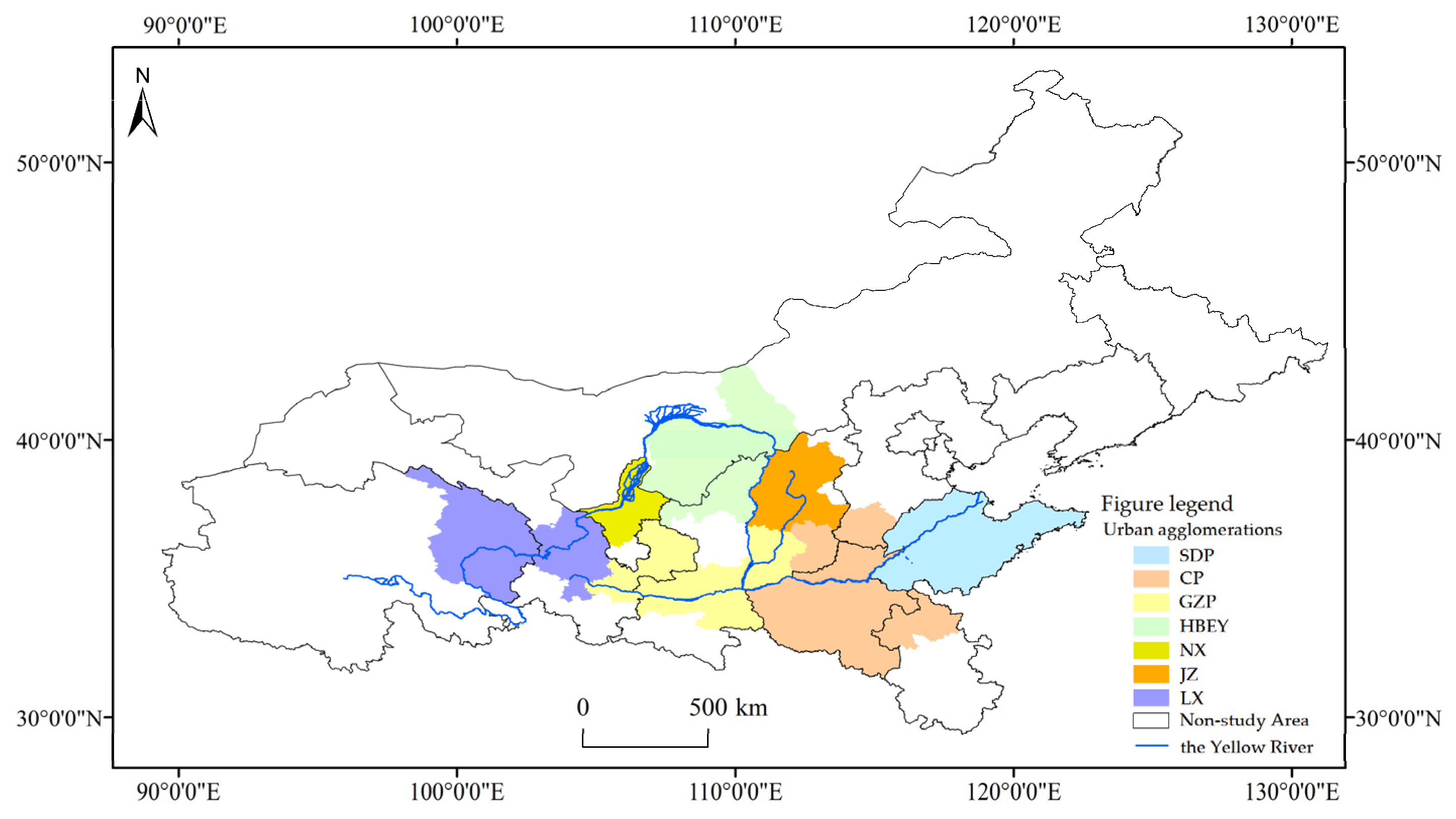
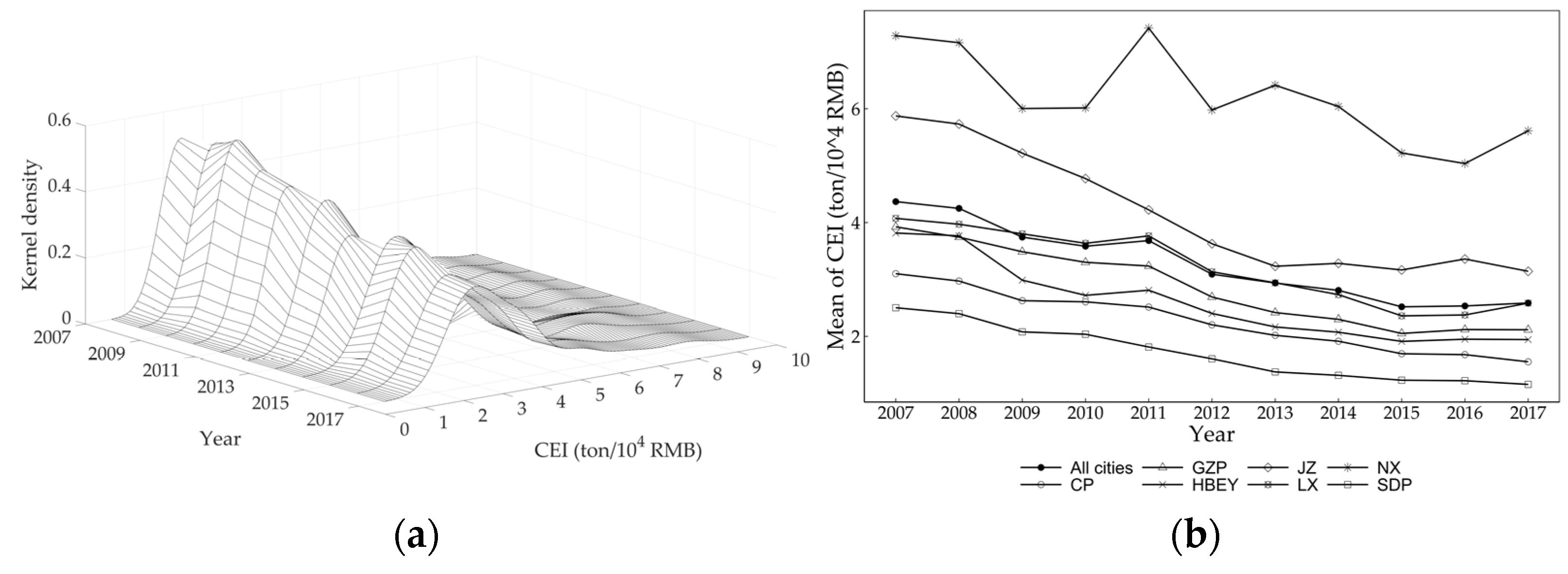
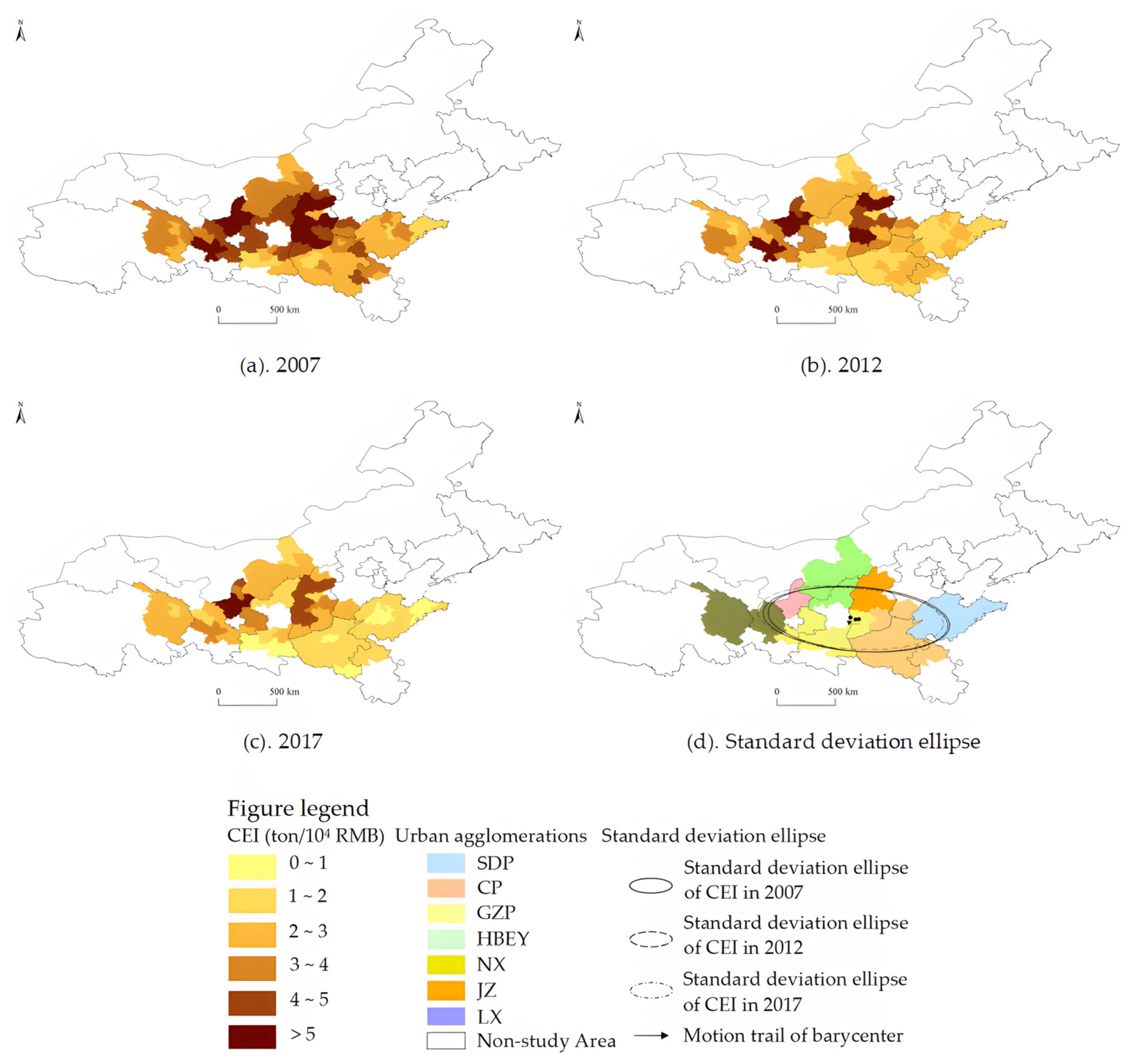
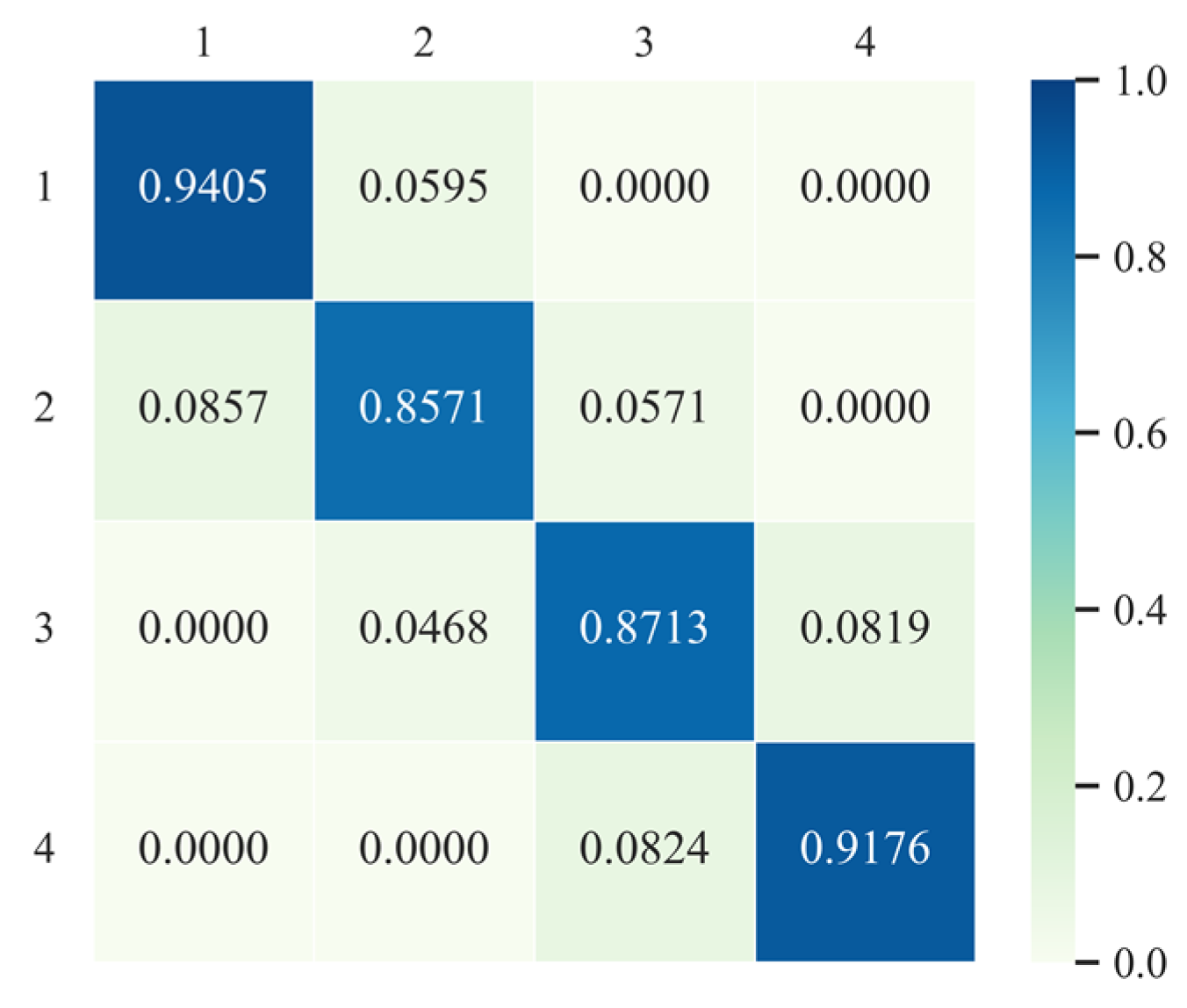
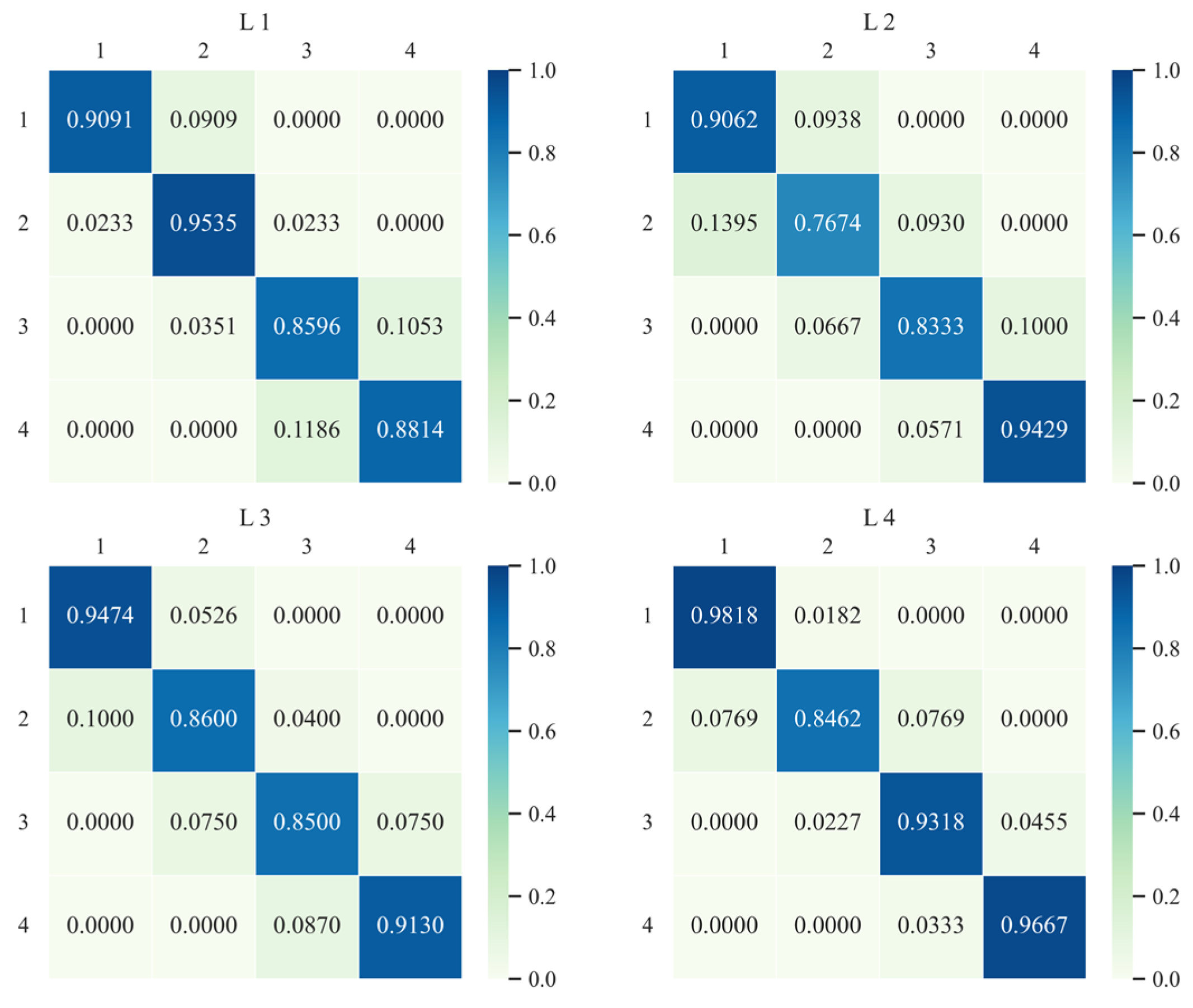
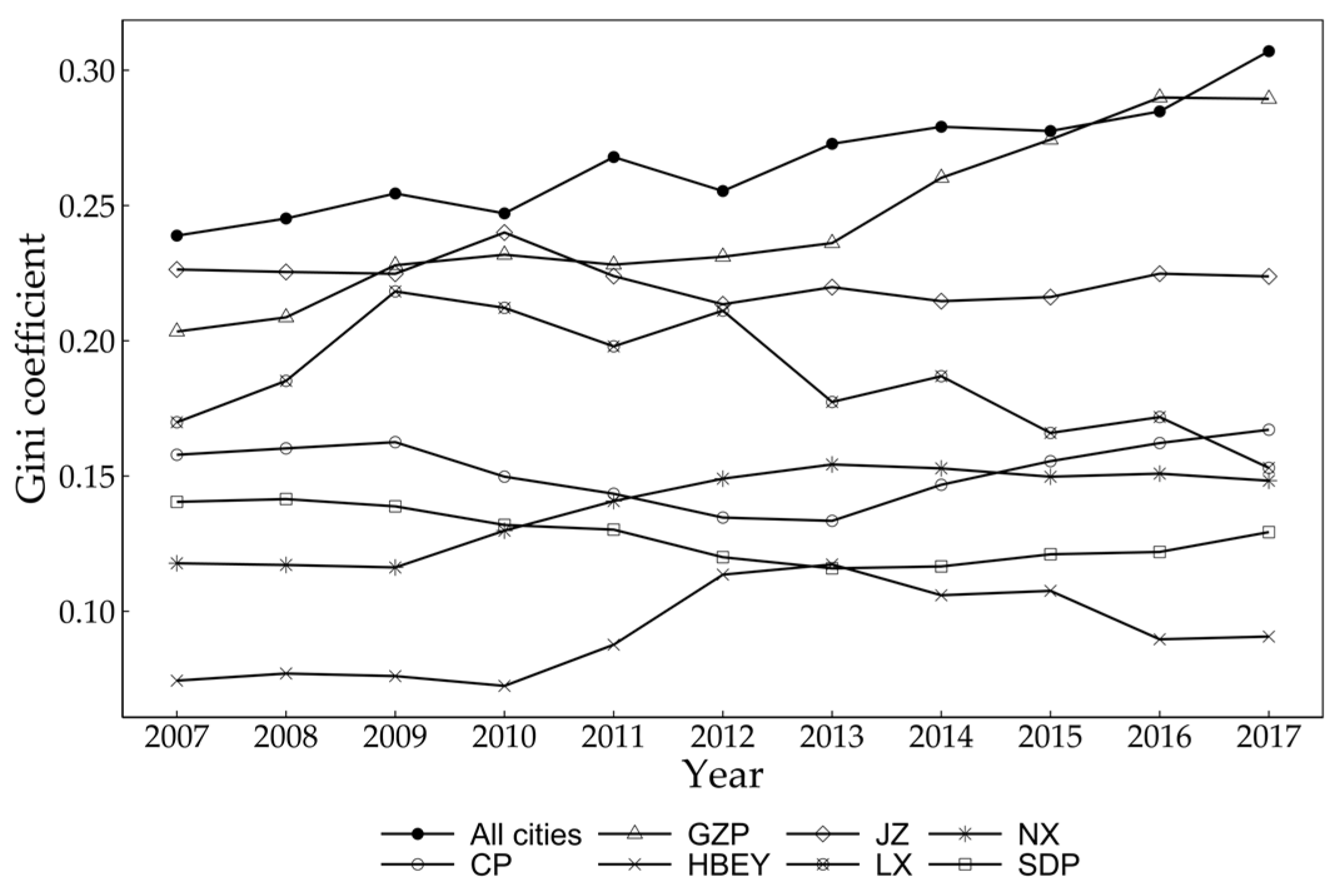
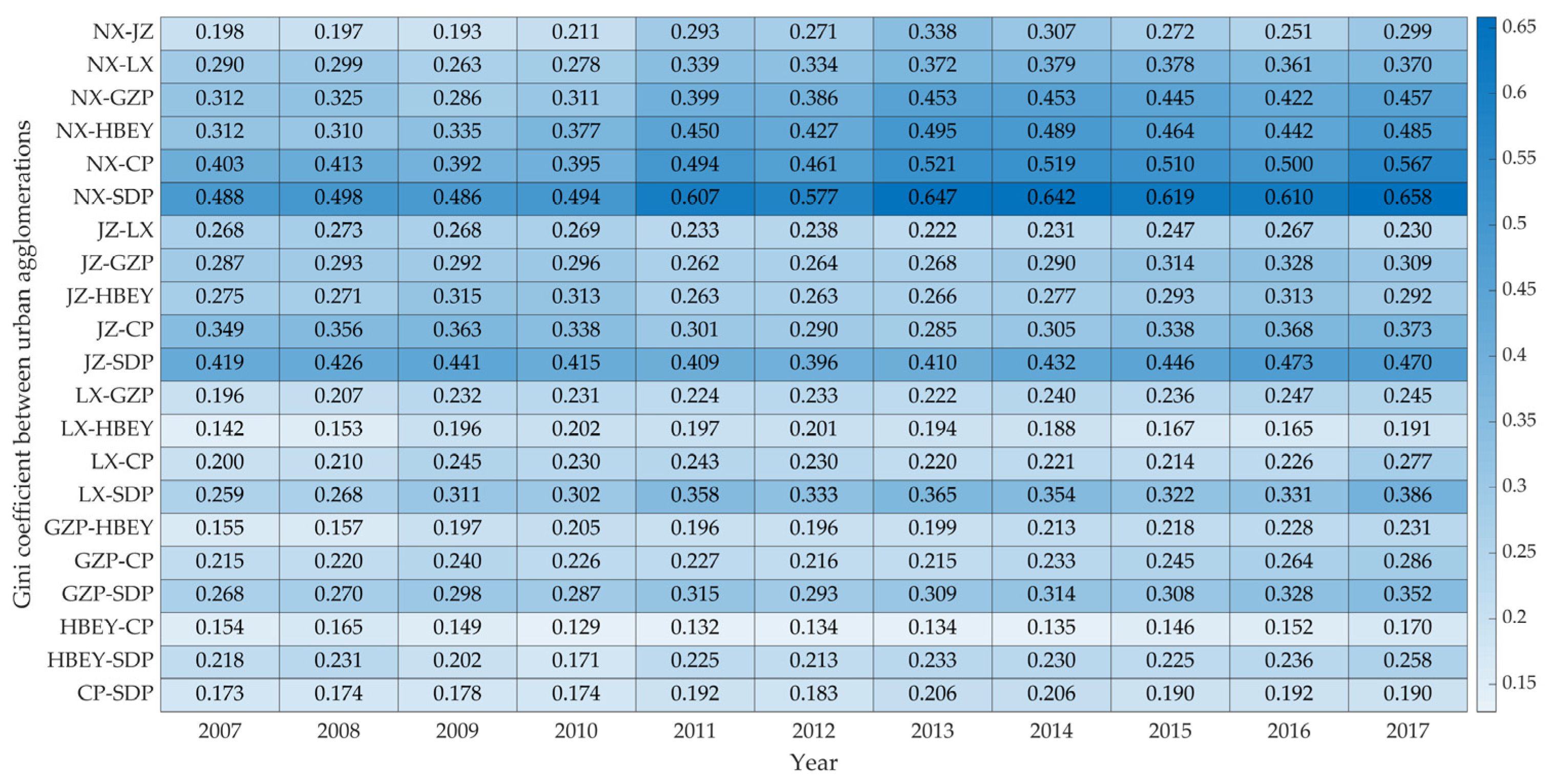
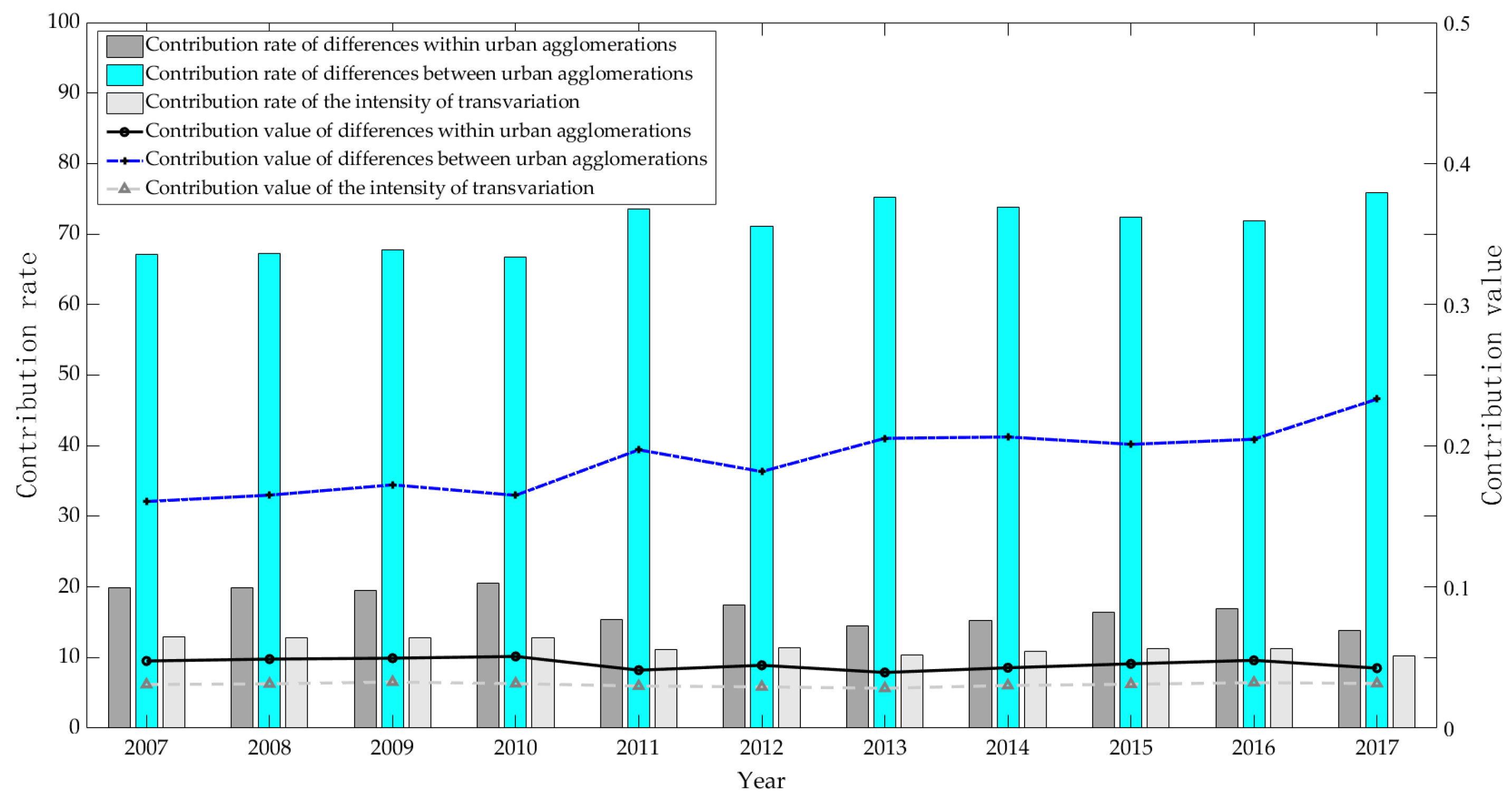
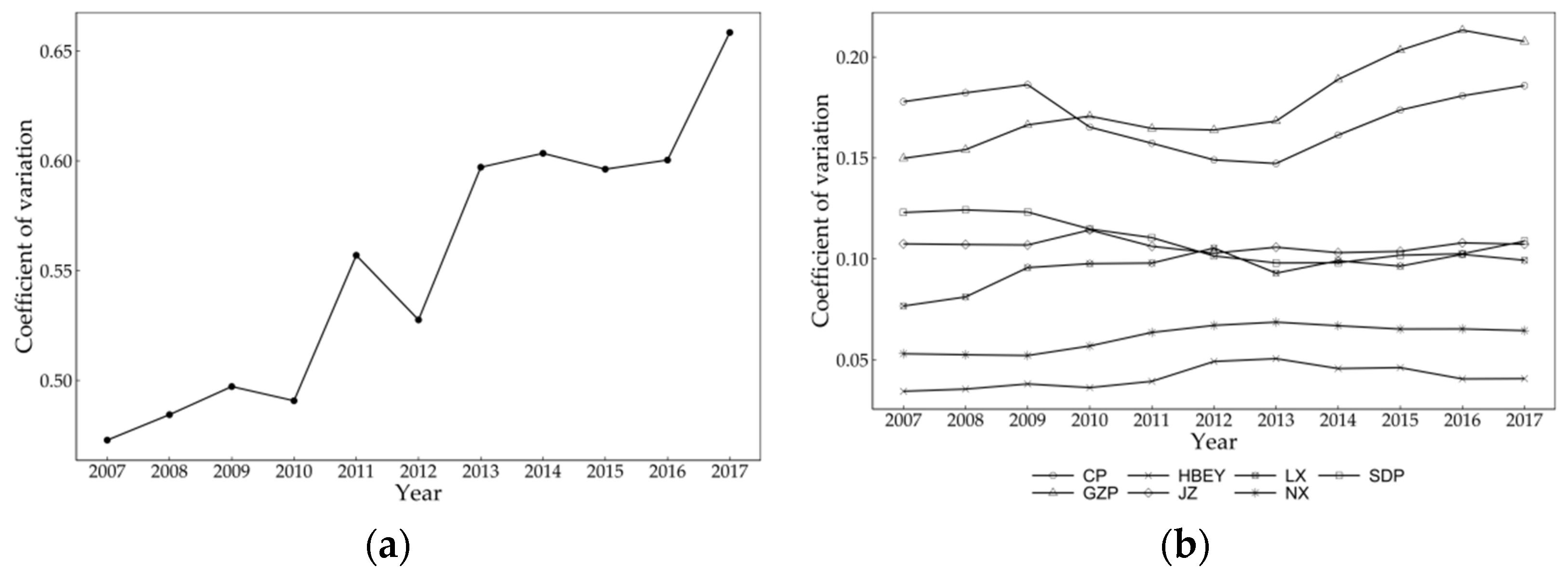
| Variables | Interpretation | Mean | Std. Dev. | Min | Max |
|---|---|---|---|---|---|
| CEI (CEI) | Total carbon emissions per unit GDP (Ton/104 RMB) | 2.74 | 1.58 | 0.71 | 9.97 |
| Urban Innovation (INNOV) | Urban Innovation Index | 4.48 | 11.90 | 0.01 | 141.48 |
| Industrial Upgrading (ISU) | The industrial structure upgrading index | 2.24 | 0.13 | 1.95 | 2.65 |
| Industrial Optimization (ISR) | The industrial structure rationalization index | 0.09 | 0.30 | 0.01 | 4.88 |
| Government’s Attention to Green Development (AGD) | Relative words frequency ratio | 1.00 | 0.34 | 0.16 | 2.40 |
| Economic Development (PRGDP) | GDP per unit population (104 RMB) | 3.59 | 2.72 | 0.34 | 18.01 |
| Population Density (PD) | Population per unit area (103 person) | 0.48 | 0.28 | 0.02 | 1.36 |
| Road Area Ratio (RAR) | Ratio of road area to built-up area | 0.17 | 0.08 | 0.01 | 1.13 |
| Year | Moran’s I | Z-Statistic | p-Value | Year | Moran’s I | Z-Statistic | p-Value |
|---|---|---|---|---|---|---|---|
| 2007 | 0.14 | 8.83 | 0.00 | 2013 | 0.16 | 10.23 | 0.00 |
| 2008 | 0.14 | 9.02 | 0.00 | 2014 | 0.15 | 9.91 | 0.00 |
| 2009 | 0.14 | 9.01 | 0.00 | 2015 | 0.14 | 9.33 | 0.00 |
| 2010 | 0.13 | 8.28 | 0.00 | 2016 | 0.14 | 9.27 | 0.00 |
| 2011 | 0.16 | 10.37 | 0.00 | 2017 | 0.16 | 10.38 | 0.00 |
| 2012 | 0.15 | 9.40 | 0.00 |
| Moran’s I | Spatial Error | Spatial Lag | ||||||||
|---|---|---|---|---|---|---|---|---|---|---|
| Statistic | p Value | LM | Robust LM | LM | Robust LM | |||||
| Statistic | p Value | Statistic | p Value | Statistic | p Value | Statistic | p Value | |||
| All cities | 59.18 | 0.00 | 203.25 | 0.00 | 36.54 | 0.00 | 182.22 | 0.0 | 15.51 | 0.00 |
| SDP | 25.37 | 0.00 | 44.79 | 0.00 | 26.93 | 0.00 | 22.05 | 0.00 | 4.20 | 0.04 |
| CP | 13.97 | 0.00 | 70.71 | 0.00 | 13.71 | 0.00 | 64.82 | 0.00 | 7.81 | 0.01 |
| GZP | 32.02 | 0.00 | 97.42 | 0.00 | 21.01 | 0.09 | 77.42 | 0.00 | 11.26 | 0.04 |
| JZ | 4.43 | 0.00 | 16.48 | 0.00 | 2.41 | 0.02 | 18.45 | 0.00 | 4.37 | 0.04 |
| NX | 6.43 | 0.00 | 36.43 | 0.00 | 5.12 | 0.12 | 40.63 | 0.00 | 9.32 | 0.00 |
| HBEY | 5.15 | 0.00 | 21.01 | 0.00 | 0.13 | 0.22 | 23.84 | 0.00 | 2.96 | 0.09 |
| LX | 3.94 | 0.00 | 12.80 | 0.00 | 1.20 | 0.07 | 13.11 | 0.00 | 1.51 | 0.02 |
| Region | All Cities | SDP | CP | GZP | JZ | NX | HBEY | LX |
|---|---|---|---|---|---|---|---|---|
| Model | SDM | SDM | SDM | SEM | SEM | SAR | SAR | SAR |
| β | −0.208 *** | −0.157 *** | −0.148 *** | −0.083 *** | −0.166 ** | −0.214 * | −0.086 *** | −0.084 * |
| (−7.879) | (−4.306) | (−4.990) | (−1.111) | (−2.026) | (−1.891) | (−2.615) | (−1.454) | |
| ρ or λ | 0.922 *** | 0.874 *** | 0.862 *** | 0.772 *** | 0.533 *** | 0.770 *** | 0.593 *** | 0.487 *** |
| −99.191 | −47.752 | −34.247 | −33.533 | −11.213 | −18.111 | −10.278 | −5.392 | |
| γ | 0.201 *** | 0.151 *** | 0.148 *** | — | — | — | — | — |
| −8.273 | −4.175 | −5.231 | ||||||
| sigma2_e | 0.002 *** | 0.001 *** | 0.001 *** | 0.002 *** | 0.003 ** | 0.002 *** | 0.003 *** | 0.005 *** |
| −7.586 | −5.002 | −3.983 | −6.209 | −2.166 | −4.917 | −4.529 | −2.863 | |
| v | 0.0233 | 0.0171 | 0.016 | 0.0087 | 0.0182 | 0.0241 | 0.009 | 0.0088 |
| Hausman Test (p value) | 94.79 (0.000) | 19.67 (0.000) | 21.15 (0.000) | 5.35 (0.021) | 4.34 (0.034) | 7.14 (0.008) | 13.80 (0.000) | 2.69 (0.011) |
| Wald Test (p Value) | 68.45 (0.000) | 17.43 (0.000) | 27.37 (0.000) | 1.89 (0.169) | 25.08 (0.000) | 3.29 (0.070) | 2.70 (0.101) | 0.49 (0.084) |
| LR Test_SAR (p Value) | 63.75 (0.000) | 17.61 (0.000) | 17.88 (0.000) | 12.20 (0.034) | 2.76 (0.097) | 2.43 (0.327) | 7.00 (0.218) | 6.44 (0.231) |
| LR Test_SEM (p Value) | 39.86 (0.027) | 2.82 (0.093) | 3.71 (0.054) | 3.24 (0.621) | 2.13 (2.289) | 1.63 (0.019) | 1.52 (0.001) | 1.55 (0.059) |
| Time Effect | YES | YES | YES | YES | YES | YES | YES | YES |
| Individual Effect | YES | YES | YES | YES | YES | YES | YES | YES |
| Moran’s I | Spatial Error | Spatial Lag | ||||||||
|---|---|---|---|---|---|---|---|---|---|---|
| Statistic | p Value | LM | Robust LM | LM | Robust LM | |||||
| Statistic | p Value | Statistic | p Value | Statistic | p Value | Statistic | p Value | |||
| All cities | 58.22 | 0.00 | 3009.15 | 0.000 | 54.10 | 0.000 | 3059.66 | 0.00 | 51.05 | 0.00 |
| SDP | 24.51 | 0.00 | 525.70 | 0.000 | 25.06 | 0.000 | 507.615 | 0.00 | 6.98 | 0.09 |
| CP | 32.35 | 0.00 | 882.00 | 0.00 | 12.54 | 0.00 | 879.60 | 0.00 | 10.14 | 0.00 |
| GZP | 12.81 | 0.00 | 140.27 | 0.00 | 1.51 | 0.02 | 153.43 | 0.00 | 14.67 | 0.04 |
| JZ | 3.310 | 0.00 | 8.41 | 0.00 | 9.87 | 0.00 | 15.17 | 0.00 | 16.62 | 0.00 |
| NX | 5.25 | 0.00 | 22.35 | 0.00 | 0.00 | 0.98 | 31.99 | 0.00 | 9.64 | 0.00 |
| HBEY | 3.98 | 0.00 | 14.22 | 0.00 | 0.26 | 0.61 | 20.94 | 0.00 | 6.98 | 0.01 |
| LX | 2.25 | 0.02 | 4.56 | 0.03 | 5.19 | 0.08 | 9.13 | 0.00 | 9.76 | 0.00 |
| Model | SDM (1) | SDM (2) | SDM (3) | SDM (4) | SDM (5) | SDM (6) | SDM (7) |
|---|---|---|---|---|---|---|---|
| β | −0.285 *** | −0.267 *** | −0.313 *** | −0.321 *** | −0.323 *** | −0.272 *** | −0.327 *** |
| (−8.016) | (−8.000) | (−6.058) | (−6.247) | (−6.177) | (−7.957) | (−6.177) | |
| ρ | 0.885 *** | 0.879 *** | 0.875 *** | 0.865 *** | 0.863 *** | 0.890 *** | 0.863 *** |
| (40.392) | (36.544) | (39.036) | (34.323) | (33.432) | (42.929) | (33.432) | |
| γ | 0.115 ** | 0.118 * | 0.134 * | 0.008 * | 0.005 * | 0.162 ** | 0.006 * |
| (1.464) | (1.892) | (1.794) | (0.081) | (0.060) | (2.157) | (0.065) | |
| INNOV | −0.001 *** | −0.001 *** | −0.001 *** | ||||
| (−3.264) | (−3.356) | (−3.356) | |||||
| ISU | −0.006 * | −0.010 | −0.009 | −0.009 | |||
| (−2.060) | (−0.093) | (−0.075) | (−0.075) | ||||
| ISR | −0.007 ** | −0.008 ** | −0.006 ** | −0.006 ** | |||
| (−1.113) | (−1.096) | (−0.900) | (−0.900) | ||||
| AGD | −0.003 ** | −0.003 ** | |||||
| (−0.560) | (−0.481) | ||||||
| sigma2_e | 0.002 *** | 0.002 *** | 0.002 *** | 0.002 *** | 0.002 *** | 0.002 *** | 0.002 *** |
| (8.124) | (8.194) | (8.779) | (8.728) | (8.652) | (8.220) | (8.652) | |
| v | 0.0335 | 0.0311 | 0.0375 | 0.0387 | 0.0390 | 0.0317 | 0.0396 |
| Hausman Test (p Value) | 133.96 (0.000) | 124.31 (0.000) | 144.96 (0.000) | 139.39 (0.000) | 145.19 (0.000) | 125.83 (0.000) | 144.53 (0.000) |
| Wald Test (p Value) | 49.24 (0.000) | 31.38 (0.000) | 44.97 (0.000) | 40.82 (0.000) | 45.14 (0.000) | 37.59 (0.000) | 54.51 (0.000) |
| LR Test_SAR (p Value) | 53.09 (0.000) | 18.45 (0.000) | 64.88 (0.000) | 60.36 (0.000) | 62.97 (0.000) | 49.54 (0.000) | 69.37 (0.000) |
| LR Test_SEM (p Value) | 36.09 (0.000) | 12.61 (0.006) | 47.76 (0.000) | 50.07 (0.000) | 53.55 (0.000) | 34.34 (0.000) | 14.84 (0.011) |
| Control Variable | YES | YES | YES | YES | YES | YES | YES |
| Time Effect | YES | YES | YES | YES | YES | YES | YES |
| Individual Effect | YES | YES | YES | YES | YES | YES | YES |
| Region | SDP | CP | GZP | JZ | NX | HBEY | LX |
|---|---|---|---|---|---|---|---|
| Model | SEM | SDM | SEM | SDM | SAR | SAR | SAR |
| β | −0.371 *** | −0.382 *** | −0.398 *** | −0.567 *** | −0.331 *** | −0.550 *** | −0.585 *** |
| (−3.264) | (−5.001) | (−3.754) | (−4.386) | (−4.201) | (−2.646) | (−4.709) | |
| ρ or λ | 0.869 *** | 0.773 *** | 0.686 *** | 0.405 *** | 0.716 *** | 0.535 *** | 0.407 *** |
| (42.487) | (14.885) | (18.840) | (5.106) | (13.783) | (7.209) | (4.077) | |
| γ | - | 0.049 * | - | 0.861 *** | - | - | - |
| (0.342) | (2.727) | ||||||
| INNOV | −0.001 ** | −0.003 *** | −0.001 | −0.022 *** | −0.003 | −0.023 * | −0.016 * |
| (−2.140) | (−3.269) | (−1.363) | (−6.115) | (−0.284) | (−1.677) | (−1.800) | |
| ISU | −0.564 ** | −0.332 *** | −0.456 ** | −0.372 *** | −0.003 | −0.009 | −0.035 |
| (−2.308) | (−3.006) | (−2.283) | (−3.099) | (−0.035) | (−0.038) | (−0.864) | |
| ISR | −0.017 ** | −0.006 * | −0.487 * | −0.052 ** | −0.685 | −0.073 ** | −0.303 * |
| (−0.248) | (−0.026) | (−1.706) | (−0.184) | (−0.639) | (−2.414) | (−0.464) | |
| AGD | −0.003 * | −0.009 * | −0.016 ** | −0.031 * | −0.041 * | −0.040 | −0.036 * |
| (−0.379) | (−1.472) | (0.995) | (−1.261) | (−1.892) | (0.730) | (−0.980) | |
| sigma2_e | 0.000 *** | 0.001 *** | 0.002 *** | 0.001 ** | 0.002 *** | 0.002 *** | 0.002 ** |
| (6.222) | (4.401) | (7.437) | (2.378) | (5.141) | (5.307) | (2.257) | |
| v | 0.0464 | 0.0481 | 0.0507 | 0.0837 | 0.0402 | 0.0799 | 0.0879 |
| Hausman Test (p Value) | 40.16 (0.000) | 41.33 (0.000) | 32.16 (0.000) | 21.80 (0.005) | 9.79 (0.073) | 11.53 (0.073) | 22.81 (0.004) |
| Wald Test (p Value) | 18.16 (0.039) | 21.76 (0.005) | 20.35 (0.009) | 12.51 (0.013) | 10.92 (0.012) | 10.09 (0.018) | 7.92 (0.048) |
| LR Tesy_SAR (p Value) | 18.16 (0.020) | 23.76 (0.003) | 9.56 (0.078) | 13.70 (0.090) | 17.37 (0.265) | 10.52 (0.230) | 8.07 (0.426) |
| LR Test_SEM (p Value) | 7.70 (0.463) | 13.90 (0.084) | 6.62 (0.297) | 14.08 (0.080) | 15.63 (0.048) | 14.44 (0.071) | 9.67 (0.049) |
| Control Variable | YES | YES | YES | YES | YES | YES | YES |
| Time Effect | YES | YES | YES | YES | YES | YES | YES |
| Individual Effect | YES | YES | YES | YES | YES | YES | YES |
| Region | All Cities | SDP | CP | GZP | ||||
|---|---|---|---|---|---|---|---|---|
| Matrix | W0–1 | We | W0–1 | We | W0–1 | We | W0–1 | We |
| Model | SDM | SDM | SDM | SEM | SDM | SAR | SEM | SEM |
| β | −0.315 *** | −0.338 *** | −0.304 ** | −0.369 *** | −0.398 *** | −0.348 *** | −0.420 *** | −0.511 *** |
| (−4.173) | (−5.161) | (−2.516) | (−3.607) | (−4.656) | (−5.736) | (−3.780) | (−6.594) | |
| ρ or λ | 0.802 *** | 0.379 *** | 0.512 *** | 0.551 *** | 0.729 *** | 0.482 *** | 0.649 *** | 0.364 *** |
| (24.610) | (9.884) | (8.091) | (8.382) | (12.467) | (10.486) | (12.299) | (4.471) | |
| γ | −0.064 | −0.084 | −0.722 *** | — | 0.158 | — | — | — |
| (−0.698) | (−1.262) | (−3.718) | (1.042) | |||||
| INNOV | −0.001 *** | −0.001 *** | −0.001 *** | −0.002 *** | −0.002 *** | −0.003 *** | −0.001 ** | −0.001 * |
| (−3.028) | (−2.764) | (3.299) | (0.068) | (−3.185) | (−2.852) | (−1.395) | (−1.857) | |
| ISU | −0.027 ** | −0.058 ** | −0.311 *** | −0.334 ** | −0.375 *** | −0.113 ** | −0.414 ** | −0.535 ** |
| (−0.254) | (0.526) | (−3.733) | (−2.036) | (−2.927) | (−1.522) | (−2.059) | (−2.430) | |
| ISR | −0.013 ** | −0.009 * | −0.110 ** | −0.180 * | −0.086 *** | −0.014 ** | −0.520 * | −0.422 * |
| (1.591) | (−0.973) | (−0.294) | (1.943) | (−0.354) | (−0.380) | (−1.833) | (−1.355) | |
| AGD | −0.011 ** | −0.004 * | 0.127 *** | −0.001 * | −0.027 * | −0.009 * | −0.011 ** | −0.028 * |
| (−1.297) | (−0.592) | (2.907) | (−0.110) | (−1.834) | (−1.393) | (−1.727) | (−0.917) | |
| sigma2_e | 0.002 *** | 0.003 *** | 0.000 *** | 0.001 *** | 0.001 *** | 0.002 *** | 0.002 *** | 0.002 *** |
| (8.401) | (7.700) | (5.713) | (4.990) | (4.252) | (5.746) | (6.964) | (7.371) | |
| v | 0.0378 | 0.0412 | 0.0362 | 0.0460 | 0.0507 | 0.0423 | 0.0545 | 0.0715 |
| Hausman Test (p Value) | 124.232 (0.000) | 194.483 (0.000) | 162.273 (0.000) | 62.298 (0.000) | 88.181 (0.000) | 75.023 (0.000) | 51.246 (0.000) | 21.529 (0.006) |
| Wald Test (p Value) | 31.421 (0.000) | 32.991 (0.000) | 58.644 (0.000) | 19.271 (0.014) | 27.236 (0.001) | 22.571 (0.001) | 76.543 (0.000) | 62.944 (0.000) |
| LR Test_SAR (p Value) | 33.447 (0.000) | 37.931 (0.000) | 53.160 (0.000) | 10.290 (0.045) | 22.976 (0.000) | 9.482 (0.304) | 57.849 (0.000) | 18.364 (0.040) |
| LR Test_SEM (p Value) | 26.755 (0.000) | 35.823 (0.000) | 43.692 (0.000) | 5.871 (0.662) | 14.572 (0.068) | 16.458 (0.036) | 61.443 (0.103) | 9.001 (0.343) |
| Control Variable | YES | YES | YES | YES | YES | YES | YES | YES |
| Time Effect | YES | YES | YES | YES | YES | YES | YES | YES |
| Individual Effect | YES | YES | YES | YES | YES | YES | YES | YES |
| Region | JZ | NX | HBEY | LX | ||||
| Matrix | W0−1 | We | W0−1 | We | W0−1 | We | W0−1 | We |
| Model | SDM | SEM | SAR | SAR | SAR | SAR | SAR | SAR |
| β | −0.528 *** | −0.534 *** | −0.272 *** | −0.283 *** | −0.521 *** | −0.567 *** | −0.581 *** | −0.593 *** |
| (−4.786) | (−5.689) | (−8.577) | (−7.895) | (−2.640) | (−4.644) | (−5.629) | (−5.597) | |
| ρ or λ | 0.482 *** | 0.497 *** | 0.734 *** | 0.317 *** | 0.557 *** | 0.407 *** | 0.378 *** | 0.306 *** |
| (6.480) | (6.877) | (13.659) | (2.791) | (6.504) | (4.449) | (3.905) | (3.255) | |
| γ | 0.697 *** | — | — | — | — | — | — | — |
| (6.508) | ||||||||
| INNOV | −0.033 *** | −0.021 *** | −0.001 ** | −0.041 * | −0.023 ** | −0.039 * | −0.014 ** | −0.016 ** |
| (−9.791) | (−4.933) | (−0.135) | (−1.782) | (−1.632) | (−1.679) | (−2.126) | (−2.151) | |
| ISU | −0.305 ** | −0.522 ** | −0.102 * | −0.014 ** | −0.021 * | −0.148 ** | −0.124 * | −0.035 * |
| (−2.506) | (−1.049) | (−0.278) | (−0.915) | (−1.151) | (−2.446) | (0.429) | (−0.191) | |
| ISR | −0.335 *** | −0.470 * | −0.622 ** | −0.488 * | −0.069 ** | −0.353 ** | −0.588 ** | −0.303 ** |
| (−3.257) | (−0.952) | (−0.646) | (−1.690) | (−2.351) | (−0.896) | (−1.209) | (−0.554) | |
| AGD | −0.110 *** | 0.026 ** | −0.039 * | −0.099 *** | −0.058 ** | −0.042 ** | −0.049 * | −0.036 * |
| (−3.436) | (−0.953) | (−1.829) | (−4.800) | (−0.602) | (−0.761) | (−1.800) | (−1.171) | |
| sigma2_e | 0.001 *** | 0.002 *** | 0.001 *** | 0.006 *** | 0.002 *** | 0.004 *** | 0.002 *** | 0.003 *** |
| (10.892) | (2.660) | (6.321) | (2.733) | (5.180) | (5.054) | (4.396) | (4.472) | |
| v | 0.0751 | 0.0764 | 0.0317 | 0.0333 | 0.0736 | 0.0837 | 0.0870 | 0.0899 |
| Hausman Test (p Value) | 18.050 (0.042) | 6.530 (0.015) | 10.920 (0.062) | 12.627 (0.012) | 10.517 (0.037) | 15.493 (0.050) | 16.314 (0.038) | 32.856 (0.000) |
| Wald Test (p Value) | 31.311 (0.000) | 39.826 (0.000) | 39.386 (0.000) | 47.188 (0.000) | 52.336 (0.000) | 56.952 (0.000) | 37.391 (0.000) | 32.025 (0.000) |
| LR Test_SAR (p Value) | 41.801 (0.000) | 10.953 (0.024) | 23.824 (0.302) | 6.458 (0.368) | 26.921 (0.170) | 28.813 (0.219) | 26.940 (0.101) | 20.716 (0.265) |
| LR Test_SEM (p Value) | 42.813 (0.000) | 8.920 (0.206) | 32.063 (0.003) | 8.701 (0.013) | 30.460 (0.002) | 36.001 (0.001) | 29.487 (0.000) | 23.197 (0.008) |
| Control Variable | YES | YES | YES | YES | YES | YES | YES | YES |
| Time Effect | YES | YES | YES | YES | YES | YES | YES | YES |
| Individual Effect | YES | YES | YES | YES | YES | YES | YES | YES |
| Region | All Cities | SDP | CP | GZP | ||||
|---|---|---|---|---|---|---|---|---|
| Model | Benchmark | One-Period Lag | Benchmark | One-Period Lag | Benchmark | One-Period Lag | Benchmark | One-Period Lag |
| β | −0.231 *** | −0.276 *** | −0.291 *** | −0.260 *** | −0.289 *** | −0.248 *** | −0.311 ** | −0.329 *** |
| (−8.098) | (−8.651) | (−3.083) | (−3.018) | (−4.429) | (−3.256) | (−2.441) | (−3.052) | |
| ρ | 0.047 *** | 0.046 *** | 0.110 *** | 0.107 *** | 0.063 *** | 0.066 *** | 0.149 *** | 0.158 *** |
| (16.072) | (16.618) | (16.391) | (15.595) | (14.930) | (16.143) | (6.935) | (8.106) | |
| INNOV | −0.001 * | −0.001 ** | −0.000 ** | −0.000 ** | −0.003 *** | −0.003 ** | −0.001 * | −0.001 * |
| (−1.765) | (−2.088) | (−1.348) | (−0.923) | (−3.293) | (−2.500) | (−0.946) | (−0.618) | |
| ISU | −0.066 *** | −0.015 *** | −0.355 *** | −0.360 ** | −0.058 *** | −0.080 ** | −0.154 ** | −0.197 ** |
| (−2.759) | (−3.002) | (−2.629) | (−2.252) | (−0.898) | (−1.062) | (−0.963) | (−0.996) | |
| ISR | −0.006 *** | −0.009 *** | −0.028 ** | −0.033 ** | −0.313 ** | −0.044 ** | −0.559 ** | −0.447 ** |
| (−0.599) | (−0.744) | (−0.288) | (−0.301) | (−1.331) | (−0.168) | (−2.620) | (−2.030) | |
| AGD | −0.006 ** | −0.007 ** | −0.002 | −0.001 | −0.006 * | −0.007 | −0.015 | −0.045 ** |
| (−0.811) | (−0.878) | (−0.088) | (−0.009) | (−0.853) | (−0.853) | (−0.820) | (−2.365) | |
| v | 0.0263 | 0.0323 | 0.0343 | 0.0301 | 0.0341 | 0.0285 | 0.0373 | 0.0399 |
| Hausman Test (p Value) | 89.949 (0.000) | 107.607 (0.000) | 36.077 (0.041) | 28.278 (0.0211) | 33.845 (0.000) | 21.005 (0.013) | 20.927 (0.013) | 19.070 (0.025) |
| Wald Test (p Value) | 568.183 (0.000) | 621.106 (0.000) | 585.568 (0.000) | 544.047 (0.000) | 381.400 (0.000) | 407.041 (0.000) | 175.243 (0.000) | 199.924 (0.000) |
| Phase1 F (p Value) | 63.131 (0.000) | 69.012 (0.000) | 65.063 (0.000) | 60.450 (0.000) | 42.3776 (0.000) | 45.2268 (0.000) | 19.471 (0.000) | 22.214 (0.000) |
| Phase2 F (p Value) | 258.309 (0.000) | 276.167 (0.000) | 268.655 (0.000) | 243.193 (0.000) | 222.904 (0.000) | 260.599 (0.000) | 48.095 (0.000) | 65.706 (0.000) |
| Control Variable | YES | YES | YES | YES | YES | YES | YES | YES |
| Time Effect | YES | YES | YES | YES | YES | YES | YES | YES |
| Individual Effect | YES | YES | YES | YES | YES | YES | YES | YES |
| Region | JZ | NX | HBEY | LX | ||||
| Model | Benchmark | One-Period Lag | Benchmark | One-Period Lag | Benchmark | One-Period Lag | Benchmark | One-Period Lag |
| β | −0.420 *** | −0.401 *** | −0.232 ** | −0.216 ** | −0.436 ** | −0.560 *** | −0.514 *** | −0.579 *** |
| (−5.090) | (−4.329) | (−2.707) | (−2.245) | (−2.280) | (−4.980) | (−3.275) | (−3.736) | |
| ρ | 0.232 *** | 0.246 *** | 0.566 *** | 0.501 *** | 0.267 *** | 0.255 *** | 0.378 *** | 0.463 *** |
| (3.501) | (3.243) | (4.971) | (4.496) | (6.443) | (8.573) | (3.645) | (3.519) | |
| INNOV | −0.020 ** | −0.010 ** | −0.005 * | −0.009 * | −0.018 * | −0.016 * | −0.011 * | −0.007 |
| (−2.123) | (−1.045) | (−0.180) | (−0.281) | (−0.813) | (−1.281) | (−1.372) | (−0.856) | |
| ISU | −0.522 * | −0.153 * | −0.041 | −0.209 * | −0.105 | −0.427 | −0.187 * | −0.207 |
| (−2.000) | (−0.601) | (−0.795) | (−2.663) | (−0.252) | (−1.358) | (−0.527) | (−0.470) | |
| ISR | −0.370 * | −0.188 * | −0.002 | −0.027 * | −0.045 | −0.177 ** | −0.700 | −0.065 |
| (−1.840) | (−0.853) | (−0.098) | (−0.526) | (−0.601) | (−2.695) | (−1.265) | (−0.156) | |
| AGD | −0.030 * | −0.057 | −0.028 ** | −0.100 * | −0.036 * | −0.007 | −0.045 ** | −0.038 * |
| (−0.770) | (−1.074) | (−0.432) | (−1.738) | (−0.664) | (−0.125) | (−1.488) | (−0.916) | |
| v | 0.0545 | 0.0512 | 0.0264 | 0.0243 | 0.0573 | 0.0821 | 0.0722 | 0.0865 |
| Hausman Test (p Value) | 26.704 (0.001) | 24.215 (0.008) | 38.579 (0.022) | 25.482 (0.003) | 16.842 (0.018) | 13.486 (0.038) | 22.941 (0.006) | 26.384 (0.002) |
| Wald Test (p Value) | 193.751 (0.000) | 182.544 (0.000) | 155.998 (0.000) | 179.736 (0.000) | 85.975 (0.000) | 79.917 (0.000) | 66.892 (0.000) | 73.433 (0.000) |
| Phase1 F (p Value) | 18.860 (0.000) | 13.172 (0.000) | 17.333 (0.000) | 32.639 (0.000) | 19.553 (0.000) | 12.013 (0.000) | 17.433 (0.000) | 12.604 (0.000) |
| Phase2 F (p Value) | 49.981 (0.000) | 39.456 (0.000) | 41.509 (0.000) | 73.500 (0.000) | 54.712 (0.000) | 38.212 (0.000) | 43.288 (0.001) | 30.515 (0.002) |
| Control Variable | YES | YES | YES | YES | YES | YES | YES | YES |
| Time Effect | YES | YES | YES | YES | YES | YES | YES | YES |
| Individual Effect | YES | YES | YES | YES | YES | YES | YES | YES |
Disclaimer/Publisher’s Note: The statements, opinions and data contained in all publications are solely those of the individual author(s) and contributor(s) and not of MDPI and/or the editor(s). MDPI and/or the editor(s) disclaim responsibility for any injury to people or property resulting from any ideas, methods, instructions or products referred to in the content. |
© 2023 by the authors. Licensee MDPI, Basel, Switzerland. This article is an open access article distributed under the terms and conditions of the Creative Commons Attribution (CC BY) license (https://creativecommons.org/licenses/by/4.0/).
Share and Cite
Zhang, C.; Dong, X.; Zhang, Z. Spatiotemporal Dynamic Distribution, Regional Differences and Spatial Convergence Mechanisms of Carbon Emission Intensity: Evidence from the Urban Agglomerations in the Yellow River Basin. Int. J. Environ. Res. Public Health 2023, 20, 3529. https://doi.org/10.3390/ijerph20043529
Zhang C, Dong X, Zhang Z. Spatiotemporal Dynamic Distribution, Regional Differences and Spatial Convergence Mechanisms of Carbon Emission Intensity: Evidence from the Urban Agglomerations in the Yellow River Basin. International Journal of Environmental Research and Public Health. 2023; 20(4):3529. https://doi.org/10.3390/ijerph20043529
Chicago/Turabian StyleZhang, Chaohui, Xin Dong, and Ze Zhang. 2023. "Spatiotemporal Dynamic Distribution, Regional Differences and Spatial Convergence Mechanisms of Carbon Emission Intensity: Evidence from the Urban Agglomerations in the Yellow River Basin" International Journal of Environmental Research and Public Health 20, no. 4: 3529. https://doi.org/10.3390/ijerph20043529
APA StyleZhang, C., Dong, X., & Zhang, Z. (2023). Spatiotemporal Dynamic Distribution, Regional Differences and Spatial Convergence Mechanisms of Carbon Emission Intensity: Evidence from the Urban Agglomerations in the Yellow River Basin. International Journal of Environmental Research and Public Health, 20(4), 3529. https://doi.org/10.3390/ijerph20043529





